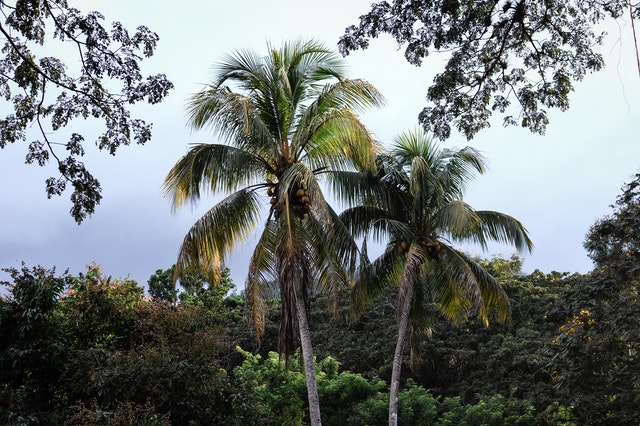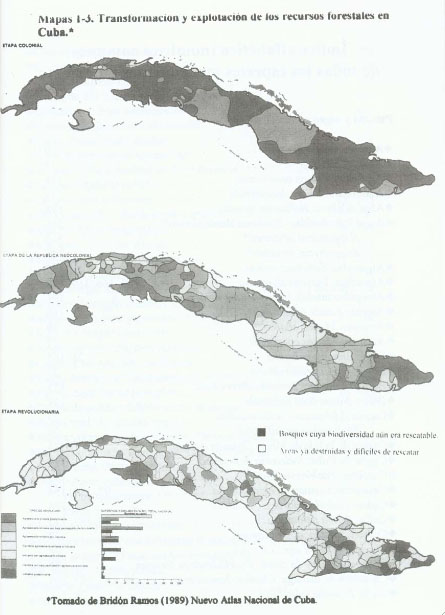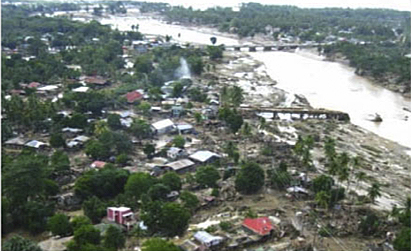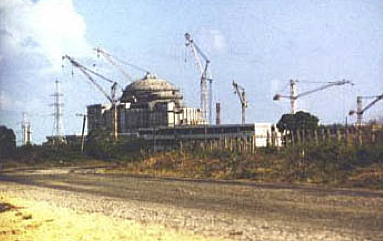
- Articles
Cuba — (Part I): The Silent War Against the Environment
While the Cuban lobby in Congress, led by the Progressive Caucus and the Democratic Socialists of America and even some misguided Republicans, like Rep. Jeff Flake, R-Ariz., in an ungodly alliance with the well-financed captains of agricultural industries and mega-corporations (e.g., Archer-Daniels-Midland, Cargill and confreres in the agribusiness industry) (1-3) continue to clamor for opening Cuba to economic exploitation in collusion with Cuba’s communist regime a silent degradation and destruction befalls Cuba’s once beautiful flora and bountiful fauna.
In this endeavor, as well as the drive to obtain hard cash by any means, the totalitarian regime of Fidel Castro reinvents itself more and more as a fascist, corporativist state rather than the socialist worker’s paradise of the bygone Cold War era.
Year after year, Cuba’s once wondrous landscape, which Christopher Columbus, Admiral of the Ocean Seas, once called “the most beautiful land that human eyes have ever seen,” is being defaced and defiled by the predatory, anti-environmental polices of Fidel Castro Ruz for the benefit of himself and the upper echelon of his regime, the privileged mayimbe class of the Cuban military.
And from the Sierra Club and other radical environmental groups we hear only deafening silence. We have to seek and extract information from the work of Carlos Wotzkow the distinguished Cuban ornithologist, concerned naturalist and ecologist, exiled in Switzerland since 1992 to find out about this environmental and ecological catastrophe being perpetrated virtually unmolested and in conspiratorial silence for over four decades of communist (fascist) rule.
Yes, environmental degradation and ecological destruction are taking place alongside tourist development in the hapless Caribbean island under the dictatorship of septuagenarian Fidel Castro and hardly anyone is complaining or even noticing this ongoing outrage.

In Wotzkow’s “Natumaleza Cubana,” (4) which unfortunately has not been translated into English, we learn that Cuba’s once unique flora and beautiful fauna are being extinguished; forests desolated; historic lakes drained and desiccated out of existence; virginal land desecrated; streams diverted, canalized to irrigate poorly tended fields; air and streams polluted by indiscriminate use of pesticides and herbicides in the zonas turisticas; improper waste disposal and drainage of fecal matter with contamination of water reservoirs everywhere.
Unless something is done to reverse the environmental degradation of the island, Wotzkow warns us, we will have a series of irreversible environmental disasters of gigantic proportions that will affect the island for years to come.
Year after year, Cuba’s natural habitats and wildlife yield to maleza, a double entendre meaning “underbrush” but also meaning “evil,” thus the jeu de mots “natumaleza” rather than naturaleza (“nature”), referring to the wanton, evil destruction of Cuba’s natural habitats and environment referred to in the title of his book.
Affirming what I wrote, based on other sources, about the Escambray Mountains of Las Villas province on this very subject in “Cuba in Revolution: Escape From a Lost Paradise,” (5) Wotzkow wrote:

“The destruction of our forests is such that were any guerrillas attempting to do today against Castro, the same deed he performed against the dictator Batista, from the Sierra Maestra, they would die from exposure and thirst. The small streams of the Sierra hardly have water, contrary to what [José] Martí [wrote], ‘they only satisfy the sea.’ Furthermore, there are no trees left to hide [in], nor is there wood left to even build a sarcophagus to the dead.”
From London, the great Cuban writer Guillermo Cabrera Infante writes, in the preface of the book, that “every page in this book is an open wound, evincing the crime of nature against nature.” Exposing this crime from outside Cuba is imperative because not only are the Cuban people misinformed by the government press but also in a repressive totalitarian regime like that in communist (fascist) Cuba, protest is impossible, and those who know must impotently yield to the censorship and infamy.
Castro’s slogan and policy logros (“achievements”) of “no drop of water can be allowed to escape to the sea” with the construction of thousands of dikes and dams to hold back the water, has been disastrous to the island, with unpredictable inundations, contamination and penetration of sea water to the water table.
The River Cauto, for example, which Cuban schoolchildren erstwhile learned was the greatest river in Cuba, is no longer so; “today, it is a mere rivulet.” Toward its outlet to the sea, the formerly fertile soil of Oriente has become arid; the coastal lakes near its delta loaded with mud; soil erosion unstoppable, denuded without the manglares (mangroves) and the sea grapes, uvas caletas (Coccoloba uvifera), that once protected and beautified that shore.
Near my native city of Sancti Spiritus and bordering on what was once my family’s small farm, the Zaza dam has caused considerable economic damage to the area with its repeated, dangerous inundations, which have left many campesinos without homes.

Roads have been washed out and nearby towns have become isolated from one another, without interconnecting roads, by these disasters. A once beautiful landscape has been destroyed by Castro’s mad vision of “not allowing one drop of water to escape to the sea.”
Notwithstanding the regime’s wild assertions and falsely contrived bureaucratic claims, the triumph of the Revolution did not improve the ecologic system of the island. On the contrary, it worsened it by subordinating the need to protect the environment, the flora and fauna, and other precious natural resources of Cuba to the political and economic exigencies of the moment, if not the whim of the all-knowing Maximum Leader.
Consider that the pluvial, mountainous forests, not to mention the consecrated Sierra Maestra herself, are today 60 percent deforested; the Escambray Mountains are 40 percent deforested, with the remainder unwisely monocultivated with Australian species of eucalyptus trees without underbrush or small trees to prevent water runoff.
As a result, soil erosion has denuded the once lush Sierra del Escambray so that, says Wotzkow, “MiG planes have no trouble spying on the ants on the ground.” The environment, wildlife and ecologic systems of these historic mountains have been sacrificed on the altar of political and military considerations.
Destruction of the environment commenced soon after the triumph of the Revolution in 1959 not only with the economic failure of agrarian reform and forced collectivization but also with ecologic degradation, which only intensified in 1989 with the collapse of Soviet communism, when Castro announced that natural resources would be exploited to the hilt as rapidly as possible in anticipation of economic collapse and implementation of the Zero Option Plan.
Matters did not improve with the subsequent imposition of the “Special Period in Peacetime” in the early 1990s.

It was at this time that Castro then raised to servile power the pliable and ruthless veterinarian Dr. Rosa Elena Simeón to “save the glorious conquest of socialism” and exploit the dwindling natural resources for the economic benefit of the State i.e., himself and his mayimbe privileged class and band of local chieftains, who do as they are told and look the other way at the environmental pillage and plunder, for their own chance at political rewards.
Dr. Simeón rules at the whim of Fidel Castro over a maze of alphabet soup and acronyms of State plundering agencies (e.g., COMARNA [Natural Resources], MINAGRI [Agriculture], INTUR [Tourism], MCTMA [Science, Technologic, and Environment], MIP [Fishing], IES [Ecology and Systematic]) all of which have placed Cuba’s natural resources at the disposal of the Revolution.
The once vast flora and fauna of Cuba, including rare and protected species, are dwindling, being sold to the highest bidders. Don’t be misled by the venal government agencies with euphemistic-sounding names such as “National Enterprise for the Protection of the Flora and Fauna” (ENPFF), which claim jurisdiction over “protected areas.” Their high-sounding names pay lip service to the international community (and the whims of the Maximum Leader) but they also participate in the pillaging and plundering of natural resources for the good of the State.
While paying lip service to conservation and other forms of government propaganda, the reality is that the regime and its agencies have built thousands of miles of roads for the development of non-existent (i.e., failure of communist central planning) State agricultural enterprises or for the tourism industry (i.e., greed), “roads through which no autos would circulate, or building dams through which there was hardly any water to contain,” writes Wotzkow.
These government “enterprises” also allow highly placed government officials like Comandante Guillermo García Frías to export racing horses and fighting gamecocks, activities that before the Revolution under Batista were considered luxuries of the bourgeoisie but which now have been reintroduced as exploitable resources. Most damaging are the lucrative sales of live or dead Cuban natural specimens to European collectors.
What is not under the guidance of Dr. Simeón (with the approval, of course, of Fidel Castro) falls under the Minister of the Interior (MININT) or Minister of the Armed Forces (MINFAR) his brother Raúl Castro. So nothing happens in Cuba without the knowledge of the Castro brothers.
How did Dr. Simeón gain her high position in the Cuban environmental sciences? Wotzkow relates here that she performed a very useful task for Fidel Castro. She blamed the African porcine fever epidemic that had erupted in Cuba in 1989 on the CIA. Then she ordered the confiscation of all pigs, which were subsequently butchered and sent to Africa as canned meat to help feed “their communist brothers” in Africa. Pigs that appeared normal were separated and shipped to feed Cuban troops in Angola.
The elimination of the porcine population in Cuba also served the purpose of ending, once and for all, Noche Buena, the traditional feast on Christmas Eve that diehard Cubans refused to give up after years of communism.
Cuba has laws, e.g., Law 33/81, “Law for the Protection of the Environment and the Rational Use of Natural Resources (ACC; 1983) but it is an empty gesture, never applied. It’s on the books for foreign consumption to pay the proverbial lip service to foreign environmentalists and useful idiots who provide hard cash to the island in grants, donations and joint enterprises.
Spurred by Spanish entrepreneurs wanting to enter into public-private partnerships or joint ventures with the Cuban government (i.e., veritable fascism/corporativism) in the hotel/tourist industry, Cuba’s once wonderful coastlines have been contaminated and polluted.

Wotzkow writes: “The coasts of Cuba are the dumping grounds for Revolutionary trash, and its cleansing is something Fidel commands to the sea. Instead of a beautiful seashell, everything you will find on our beaches is dangerous. From floating human feces, as one finds in Guanabo beach, to bloody and purulent bandages that are discarded directly into the sea from the coastal hotels to be dispersed by the waves of the sea.”
Whole schools of fish have disappeared, collected and ground for animal fodder (pienso). Even the sand has been exhausted from many beaches, to be used for concrete and gravel to build coastal roads (pedraplenes) for tourist development, through which no one travels except inspecting government dignitaries.
This has been the desolation that has been wrought on the northern coastal areas and the keys of the archipelago of Sabana-Camagüey, especially in remote Cayo Coco and Cayo Romano. Wotzkow estimates that at least 18 square kilometers of this fragile natural habitat of virginal, subtropical forests have been destroyed, piles of unused timber left rotting along the side of the deserted pedraplenes leading nowhere.
Chaos reigns; government work projects start here and there but are never completed, leaving deforestation and destruction in their wake. The situation has been worsened by Castro’s misdirected, anti-environmental policies for rural development, as in the youth working farms, “Escuela al Campo,” and State-directed recreation, “Campismo Popular.”
In Cuba — (Part II): The Hunter and the Hunted in the Lost Caribbean Paradise, we will conclude this exposé, bringing to light the wanton destruction of a once thriving Caribbean paradise.
References
1. See Faria MA Jr. Prospecting for Fool’s Gold in Cuba Again. NewsMax.com, May 16, 2002.
2. Snow A. Americans to push U.S. food in Cuba. Associated Press, September 26, 2002.
3. Bauzá V. Companies aim for Cuban cupboards. South Florida Sun-Sentinel (Havana bureau), September 27, 2002.
4. Wotzkow C. Natumaleza Cubana. Ediciones Universales, P.O. Box 450353, Miami, FL 33245-0353, 1998.
5. Faria MA Jr. Cuba in Revolution: Escape From a Lost Paradise. Macon, GA, Hacienda Publishing, Inc., 2002, pp. 88-116. https://HaciendaPublishing.com.
Written by Dr. Miguel Faria
Miguel A. Faria Jr., M.D., is Editor-in-Chief of the Medical Sentinel () and author of “Vandals at the Gates of Medicine” (1995); “Medical Warrior: Fighting Corporate Socialized Medicine” (1997); and for the lesson of gun control in Cuba, see his latest book, “Cuba in Revolution: Escape From a Lost Paradise” (2002). All three books are available from www.haciendapub.com.
This article may be cited as: Faria MA. Cuba — (Part I): The Silent War Against the Environment. HaciendaPublishing.com, February 10, 2012. Available from: https://haciendapublishing.com/cuba-part-i-the-silent-war-against-the-environment/
Originally published in NewsMax.com on November 2, 2002. It has been updated with photos for Hacienda Publishing.